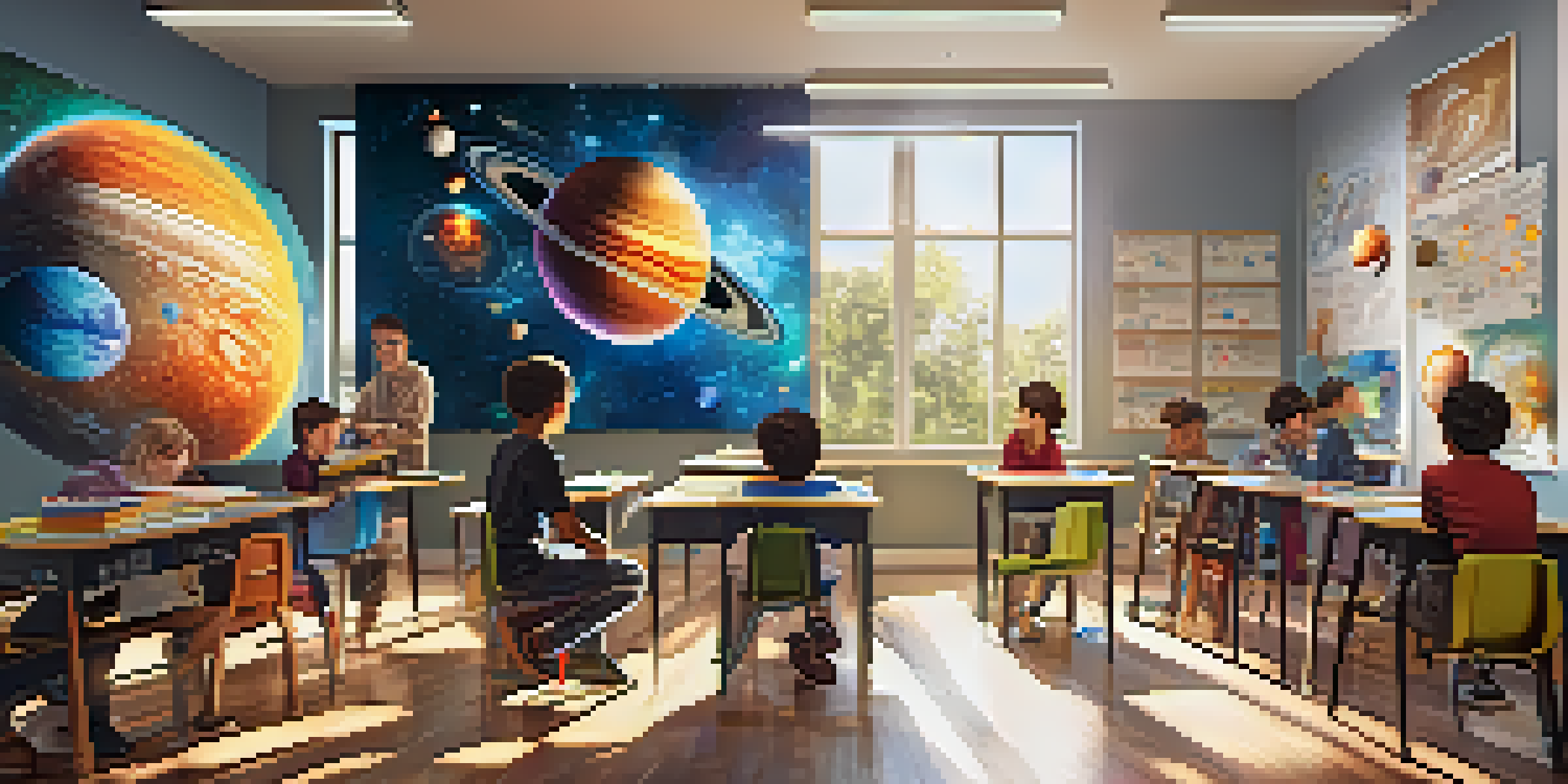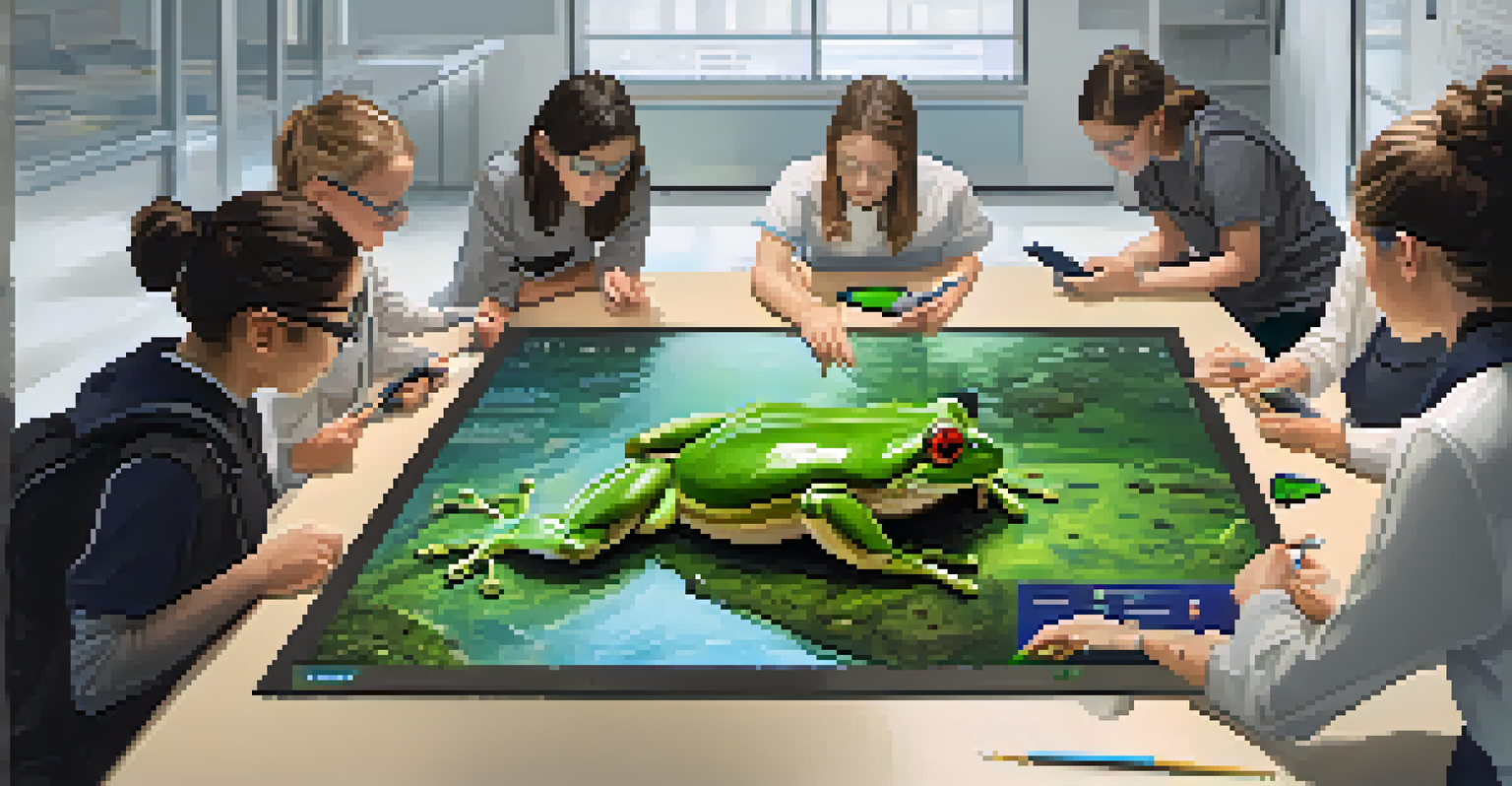Benefits of Augmented Reality for Interactive Learning

What is Augmented Reality and How Does It Work?
Augmented Reality (AR) overlays digital information onto the real world, enhancing our perception of reality. Imagine looking through your smartphone camera and seeing a dinosaur roam your backyard, thanks to AR technology. By combining computer-generated images with our physical surroundings, AR creates engaging and immersive learning experiences that captivate students' attention.
The great aim of education is not knowledge but action.
In education, this technology can transform traditional learning into an interactive adventure. For instance, students can explore historical landmarks or complex scientific concepts without leaving their classroom. This accessibility not only makes learning fun but also helps students visualize information in a more meaningful way.
Moreover, AR applications can be tailored to individual learning styles, allowing for personalized education. Whether a student learns best through visual aids or hands-on experiences, AR can adapt to meet these diverse needs, making it a powerful tool in interactive learning.
Boosting Engagement Through Immersive Experiences
One of the standout benefits of AR in education is its ability to boost student engagement. When learning involves interactive elements, students are more likely to participate and retain information. Imagine a biology class where students can dissect a virtual frog, feeling the excitement of hands-on learning without the mess.

This immersive experience encourages curiosity, prompting students to ask questions and explore topics deeper. By transforming abstract concepts into tangible experiences, AR fosters a more engaging classroom environment. The result? Increased motivation and a love for learning that can last a lifetime.
AR Enhances Learning Engagement
Augmented Reality makes learning interactive and immersive, significantly boosting student involvement and retention.
Furthermore, AR makes learning collaborative. Students can work together on projects, experiencing the thrill of discovery side by side. This teamwork not only enhances social skills but also reinforces learning as they share their insights and findings with one another.
Enhancing Retention Through Interactive Learning
Interactive learning through AR has been shown to improve information retention significantly. Studies suggest that students who engage with material in a hands-on way tend to remember it longer. By allowing learners to visualize and interact with complex subjects, AR helps solidify knowledge in a fun and memorable manner.
Education is not the filling of a pail, but the lighting of a fire.
For example, in a history lesson, students can witness pivotal events unfold right before their eyes, making the past feel alive. This vivid experience creates emotional connections to the material, making it easier to recall details later on. It's much harder to forget what you 'saw' compared to what you 'read' in a textbook.
Moreover, the instant feedback provided by AR applications enables students to learn from their mistakes in real-time. This immediate reinforcement encourages a growth mindset, where students feel more confident to tackle challenging concepts without the fear of failure.
Fostering Critical Thinking and Problem-Solving Skills
AR encourages students to think critically and develop problem-solving skills. When faced with challenges presented in an AR environment, learners must analyze situations, make decisions, and adapt their strategies. For instance, a math problem can transform into a virtual puzzle that students must solve collaboratively.
This hands-on approach not only makes learning enjoyable but also prepares students for real-world challenges. As they engage with interactive scenarios, they learn to approach problems from different angles—a vital skill in today’s ever-changing landscape. It's like training for a marathon; the more you practice, the better you become.
Fosters Critical Thinking Skills
AR encourages students to tackle real-world challenges, enhancing their problem-solving abilities and critical thinking.
Additionally, AR promotes an inquiry-based learning approach, where students are encouraged to ask questions and explore solutions. This process nurtures natural curiosity, empowering learners to take ownership of their education and develop a lifelong love for learning.
Bridging the Gap in Remote Learning Environments
The rise of remote learning has highlighted the importance of engaging educational tools, and AR fits the bill perfectly. It provides a way to bridge the gap between traditional classroom experiences and virtual learning. Imagine a student attending a virtual lecture where they can interact with 3D models of the solar system from their living room.
This capability not only keeps students engaged but also allows them to explore concepts at their own pace. By incorporating AR into remote learning, educators can create dynamic lessons that hold students' attention, making the digital learning experience feel more personal and interactive.
Moreover, AR tools can help teachers assess understanding in real-time, allowing for immediate adjustments to their teaching strategies. This responsiveness is crucial in a remote setting, where students may struggle to stay focused or grasp complex topics.
Making Learning Accessible for All Students
One of the most commendable aspects of AR is its potential to make learning more accessible for diverse learners. Students with different abilities can benefit from AR's visual and interactive elements, catering to various learning styles. For example, a child with dyslexia can better understand reading material through engaging visual stories created with AR.
Additionally, AR can simplify complex topics, breaking them down into manageable parts. This approach is particularly helpful for students who may struggle with traditional teaching methods, offering them alternative ways to grasp challenging content. It's like having a personalized tutor available at the touch of a button.
Bridges Gaps in Remote Education
Augmented Reality effectively connects traditional classroom experiences with virtual learning, making lessons more engaging and accessible.
Furthermore, AR can facilitate inclusive education by providing tools that cater to different needs. By leveling the playing field, AR ensures that every student can participate and thrive in their learning journey, regardless of their background or abilities.
Preparing Students for the Future Workforce
As technology continues to evolve, equipping students with the skills they need for future careers is paramount. AR provides a unique platform to develop digital literacy and technical skills that are increasingly in demand in the job market. Through AR experiences, students can gain hands-on experience with tools they may encounter in their future careers.
For instance, fields like engineering and healthcare are utilizing AR for training and simulations. Students can practice procedures in a risk-free environment, gaining confidence and competence before entering the workforce. This practical experience is invaluable and sets them apart in competitive job markets.

Moreover, by fostering creativity and innovation through AR, students learn to think outside the box. They become adept at using technology to solve problems, making them well-prepared for careers that require adaptability and forward-thinking. In essence, AR not only enriches education but also shapes the innovators and leaders of tomorrow.